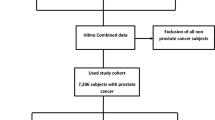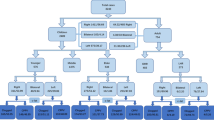Abstract
The two most frequently occurring and well-described complications of radical retropubic prostatectomy (RRP) for prostate cancer are incontinence and impotence. Inguinal hernia (IH) has, over the last decade, emerged as an additional complication, with an estimated incidence of 15–20% after RRP. IH is a common lesion in men aged between 50 and 70 years with or without prostate cancer, and the literature indicates that annual incidence is somewhere between 0.5% and 1% in the general male population. Important risk factors for the development of post-RRP IH are previous IH surgery, increasing age, and low BMI. However, subclinical IH at the time of RRP and a lower midline incision seem to be the most important causative factors. Prophylactic procedures and, in the case of clinically detectable IH lesions, concurrent repair during RRP are advocated. Reports on alternative approaches to RRP, such as minilaparotomy RRP, laparoscopic radical prostatectomy (including robot-assisted procedures) and radical perineal prostatectomy have indicated low rates of postoperative IH. The risk of developing IH after prostatectomy should be part of the preoperative risk assessment when making treatment decisions for patients with prostate cancer.
Key Points
-
Inguinal hernia (IH) is an established postoperative complication of radical retropubic prostatectomy (RRP) with an estimated incidence of 15–20%
-
Subclinical or clinically detectable IH at the time of surgery and use of a lower midline incision are associated with a higher risk of developing postoperative IH
-
Other constitutional factors such as increasing age and low BMI might also contribute to IH development
-
In patients with clinically detectable IH before surgery, concurrent repair of IH at the time of RRP and a prophylactic procedure on the contralateral side should be considered
-
Prophylactic procedures should be performed on both sides in patients without detectable IH before surgery
-
The risk of IH after laparoscopic radical prostatectomy procedures seems to be lower than after RRP
This is a preview of subscription content, access via your institution
Access options
Subscribe to this journal
Receive 12 print issues and online access
$209.00 per year
only $17.42 per issue
Buy this article
- Purchase on Springer Link
- Instant access to full article PDF
Prices may be subject to local taxes which are calculated during checkout
Similar content being viewed by others
References
Walsh, P. C., Lepor, H. & Eggleston, J. C. Radical prostatectomy with preservation of sexual function: anatomical and pathological considerations. Prostate 4, 473–485 (1983).
Pirtskhalaishvili, G., Hrebinko, R. L. & Nelson, J. B. The treatment of prostate cancer: an overview of current options. Cancer Pract. 9, 295–306 (2001).
Heidenreich, A. et al. EAU guidelines on prostate cancer. Part 1: screening, diagnosis, and treatment of clinically localised disease. Eur. Urol. 59, 61–71 (2010).
Walsh, P. C. Anatomic radical prostatectomy: evolution of the surgical technique. J. Urol. 160, 2418–2424 (1998).
Salomon, L. et al. Combined reporting of cancer control and functional results of radical prostatectomy. Eur. Urol. 44, 656–660 (2003).
Walsh, P. C. in Campbell's Urology 8th edn (eds Walsh, P. C. et al.) 3107–3129 (Saunders, Philadelphia, 2002).
Bianco, F. J. Jr, Scardino, P. T. & Eastham, J. A. Radical prostatectomy: long-term cancer control and recovery of sexual and urinary function (“trifecta”). Urology 66 (Suppl. 5), 83–94 (2005).
Regan, T. C., Mordkin, R. M., Constantinople, N. L., Spence, I. J. & Dejter, S. W. Jr . Incidence of inguinal hernias following radical retropubic prostatectomy. Urology 47, 536–537 (1996).
Ichioka, K. et al. High incidence of inguinal hernia after radical retropubic prostatectomy. Urology 63, 278–281 (2004).
Stranne, J., Hugosson, J. & Lodding, P. Inguinal hernia is a common complication in lower midline incision surgery. Hernia 11, 247–252 (2007).
Sekita, N. et al. Incidence of inguinal hernia after prostate surgery: open radical retropubic prostatectomy versus open simple prostatectomy versus transurethral resection of the prostate. Int. J. Urol. 16, 110–113 (2009).
Lodding, P. et al. Inguinal hernia after radical retropubic prostatectomy for prostate cancer: a study of incidence and risk factors in comparison to no operation and lymphadenectomy. J. Urol. 166, 964–967 (2001).
Sun, M. et al. Comparative study of inguinal hernia repair after radical prostatectomy, prostate biopsy, transurethral resection of the prostate or pelvic lymph node dissection. J. Urol. 183, 970–975 (2010).
Skandalakis, J. E., Colborn, G. L., Skandalakis, L. J. & McClusky, D. A. III . in Nyhus and Condon's Hernia 5th edn (eds Fitzgibbons, R. J. J. & Greenburg, A. G.) 29–43 (Lippincott Williams & Wilkins, Philadelphia, 2002).
Tsai, P. J., Yu, C. C., Lee, Y. H. & Huang, J. K. Inguinal hernia after radical retropubic prostatectomy-experience of Kaohsiung Veterans General Hospital. J. Chin. Med. Assoc. 67, 141–144 (2004).
Nomura, T. et al. Lower incidence of inguinal hernia: minilaparotomy radical retropubic prostatectomy compared with conventional technique. A preliminary report. Urol. Int. 74, 32–37 (2005).
Twu, C. M., Ou, Y. C., Yang, C. R., Cheng, C. L. & Ho, H. C. Predicting risk factors for inguinal hernia after radical retropubic prostatectomy. Urology 66, 814–818 (2005).
Fukuta, F. et al. Preoperative computed tomography finding predicts for postoperative inguinal hernia: new perspective for radical prostatectomy-related inguinal hernia. Urology 68, 267–271 (2006).
Stranne, J., Hugosson, J. & Lodding, P. Post-radical retropubic prostatectomy inguinal hernia: an analysis of risk factors with special reference to preoperative inguinal hernia morbidity and pelvic lymph node dissection. J. Urol. 176, 2072–2076 (2006).
Abe, T. et al. Postoperative inguinal hernia after radical prostatectomy for prostate cancer. Urology 69, 326–329 (2007).
Matsubara, A. et al. Inguinal hernia after radical perineal prostatectomy: comparison with the retropubic approach. Urology 70, 1152–1156 (2007).
Koie, T. et al. Frequency of postoperative inguinal hernia after endoscope-assisted mini-laparotomy and conventional retropubic radical prostatectomies. Int. J. Urol. 15, 226–229 (2008).
Lepor, H. & Robbins, D. Inguinal hernias in men undergoing open radical retropubic prostatectomy. Urology 70, 961–964 (2007).
Stranne, J. et al. Inguinal hernia after radical prostatectomy for prostate cancer: results from a randomized setting and a nonrandomized setting. Eur. Urol. 58, 719–726 (2010).
Abramson, J. H., Gofin, J., Hopp, C., Makler, A. & Epstein, L. M. The epidemiology of inguinal hernia. A survey in western Jerusalem. J. Epidemiol. Community Health 32, 59–67 (1978).
Rubenstein, R. S. et al. Conceptualization and measurement of physiologic health for adults Vol. 15 Surgical Conditions (RAND, Santa Monica, 1983).
Rutkow, I. M. Epidemiologic, economic, and sociologic aspects of hernia surgery in the United States in the 1990s. Surg. Clin. North Am. 78, 941–951 (1998).
Lughezzani, G. et al. Comparative study of inguinal hernia repair rates after radical prostatectomy or external beam radiotherapy. Int. J. Radiat. Oncol. Biol. Phys. 78, 1307–1313 (2010).
Stranne, J., Hugosson, J., Iversen, P., Morris, T. & Lodding, P. Inguinal hernia in stage M0 prostate cancer: a comparison of incidence in men treated with and without radical retropubic prostatectomy-an analysis of 1105 patients. Urology 65, 847–851 (2005).
Nielsen, M. E. & Walsh, P. C. Systematic detection and repair of subclinical inguinal hernias at radical retropubic prostatectomy. Urology 66, 1034–1037 (2005).
Matthews, R. D. & Neumayer, L. Inguinal hernia in the 21st century: an evidence-based review. Curr. Probl. Surg. 45, 261–312 (2008).
Lau, H., Fang, C., Yuen, W. K. & Patil, N. G. Risk factors for inguinal hernia in adult males: a case-control study. Surgery 141, 262–266 (2007).
Ichioka, K., Kohei, N., Yoshimura, K., Arai, Y. & Terai, A. Impact of retraction of vas deferens in postradical prostatectomy inguinal hernia. Urology 70, 511–514 (2007).
Marien, T., Taouli, B., Telegrafi, S., Babb, J. & Lepor, H. Optimizing the detection of subclinical inguinal hernias in men undergoing open radical retropubic prostatectomy. BJU Int. 106, 1468–1472 (2010).
Rosemar, A., Angerås, U. & Rosengren, A. Body mass index and groin hernia: a 34-year follow-up study in Swedish men. Ann. Surg. 247, 1064–1068 (2008).
Rabbani, F., Yunis, L. H., Touijer, K. & Brady, M. S. Predictors of inguinal hernia after radical prostatectomy. Urology 77, 391–395 (2010).
Yoshimine, S. et al. Extraperitoneal approach induces postoperative inguinal hernia compared with transperitoneal approach after laparoscopic radical prostatectomy. Jpn J. Clin. Oncol. 40, 349–352 (2010).
Allaf, M. E., Hsu, T. H., Sullivan, W. & Su, L. M. Simultaneous laparoscopic prosthetic mesh inguinal herniorrhaphy during transperitoneal laparoscopic radical prostatectomy. Urology 62, 1121 (2003).
Ghavamian, R., Knoll, A. & Teixeira, J. A. Simultaneous extraperitoneal laparoscopic radical prostatectomy and intraperitoneal inguinal hernia repair with mesh. JSLS 9, 231–234 (2005).
Teber, D., Erdogru, T., Zukosky, D., Frede, T. & Rassweiler, J. Prosthetic mesh hernioplasty during laparoscopic radical prostatectomy. Urology 65, 1173–1178 (2005).
Finley, D. S., Rodriguez, E. Jr & Ahlering, T. E. Combined inguinal hernia repair with prosthetic mesh during transperitoneal robot assisted laparoscopic radical prostatectomy: a 4-year experience. J. Urol. 178, 1296–1299 (2007).
Lee, B. C., Rodin, D. M., Shah, K. K. & Dahl, D. M. Laparoscopic inguinal hernia repair during laparoscopic radical prostatectomy. BJU Int. 99, 637–639 (2007).
Joshi, A. R., Spivak, J., Rubach, E., Goldberg, G. & DeNoto, G. Concurrent robotic trans-abdominal pre-peritoneal (TAP) herniorrhaphy during robotic-assisted radical prostatectomy. Int. J. Med. Robot. 6, 311–314 (2010).
Stranne, J. Inguinal Hernia after Urologic Surgery in Males with Special Reference to Radical Retropubic Prostatectomy—A Clinical, Epidemiological and Methodological Study [online]. Thesis, Göteborg University http://gupea.ub.gu.se/handle/2077/706 (2006).
Stranne, J. Inguinal hernia as a complication to urological lower midline incision surgery. Review Series Urology 12, 2–8 (2008).
Schlegel, P. N. & Walsh, P. C. The use of the preperitoneal approach for the simultaneous repair of inguinal hernia during surgery on the bladder and prostate. World J. Surg. 13, 555–559 (1989).
Choi, B. B., Steckel, J., Denoto, G., Vaughan, E. D. & Schlegel, P. N. Preperitoneal prosthetic mesh hernioplasty during radical retropubic prostatectomy. J. Urol. 161, 840–843 (1999).
Savetsky, I. L., Rabbani, F., Singh, K. & Brady, M. S. Preperitoneal repair of inguinal hernia at open radical prostatectomy. Hernia 13, 517–522 (2009).
Antunes, A. A., Dall'oglio, M., Crippa, A. & Srougi, M. Inguinal hernia repair with polypropylene mesh during radical retropubic prostatectomy: an easy and practical approach. BJU Int. 96, 330–333 (2005).
Drachenberg, D. E. & Bell, D. G. Preperitoneal mesh-plug herniorraphy during radical retropubic prostatectomy. Can. J. Urol. 9, 1602–1606 (2002).
Manoharan, M., Vyas, S., Araki, M., Nieder, A. M. & Soloway, M. S. Concurrent radical retropubic prostatectomy and Lichtenstein inguinal hernia repair through a single modified Pfannenstiel incision: a 3-year experience. BJU Int. 98, 341–344 (2006).
Sakai, Y. et al. Simple prophylactic procedure of inguinal hernia after radical retropubic prostatectomy: isolation of the spermatic cord. Int. J. Urol. 16, 848–851 (2009).
Fujii, Y. et al. A novel technique to prevent postradical retropubic prostatectomy inguinal hernia: the processus vaginalis transection method. Urology 75, 713–717 (2009).
Taguchi, K. et al. Simple method of preventing postoperative inguinal hernia after radical retropubic prostatectomy. Urology 76, 1083–1087 (2010).
Stranne, J. et al. Post-radical prostatectomy inguinal hernia: a simple surgical intervention can substantially reduce the incidence-results from a prospective randomized trial. J. Urol. 184, 984–989 (2010).
Author information
Authors and Affiliations
Contributions
J. Stranne and P. Lodding contributed equally to researching the article, discussion of content and editing the manuscript before subscription. J. Stranne wrote the article.
Corresponding author
Ethics declarations
Competing interests
The authors declare no competing financial interests.
Rights and permissions
About this article
Cite this article
Stranne, J., Lodding, P. Inguinal hernia after radical retropubic prostatectomy: risk factors and prevention. Nat Rev Urol 8, 267–273 (2011). https://doi.org/10.1038/nrurol.2011.40
Published:
Issue Date:
DOI: https://doi.org/10.1038/nrurol.2011.40
This article is cited by
-
Risk of hernia formation after radical prostatectomy: a comparison between open and robot-assisted laparoscopic radical prostatectomy within the prospectively controlled LAPPRO trial
Hernia (2022)
-
Preoperative CT findings of subclinical hernia can predict for postoperative inguinal hernia following robot-assisted laparoscopic radical prostatectomy
Abdominal Radiology (2018)
-
Causative factors for de novo inguinal hernia after robot-assisted radical prostatectomy
Journal of Robotic Surgery (2018)
-
The cumulative incidence and risk factors of postoperative inguinal hernia in patients undergoing radical prostatectomy
International Journal of Clinical Oncology (2018)
-
Prophylactic procedure for inguinal hernia after radical retropubic prostatectomy
Hernia (2015)



